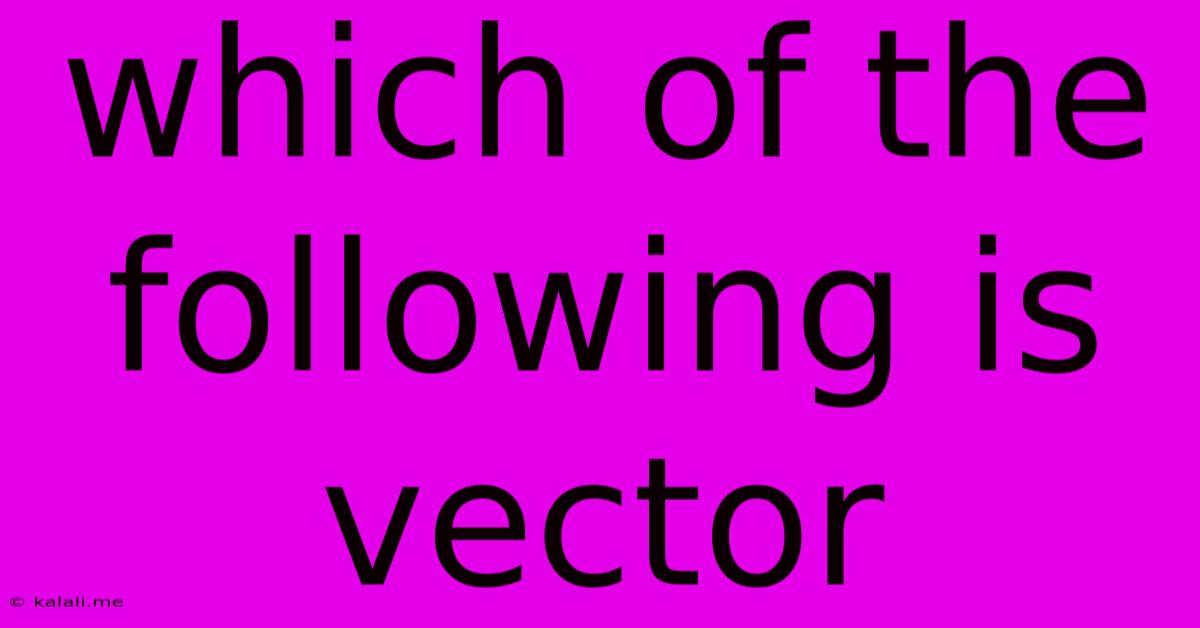Which Of The Following Is Vector
Kalali
Jun 15, 2025 · 2 min read

Table of Contents
Which of the Following is a Vector? Understanding Vectors and Scalars
This article will explore the fundamental difference between vectors and scalars, helping you understand which quantities are represented as vectors. We'll clarify the concept and provide examples to solidify your understanding. This is crucial for anyone studying physics, engineering, or mathematics.
What is a Vector?
A vector is a quantity that has both magnitude (size) and direction. This is in contrast to a scalar, which only has magnitude. Think of it like this: a scalar tells you how much, while a vector tells you how much and which way.
Key Characteristics of Vectors:
- Magnitude: This represents the size or length of the vector. It's always a positive value.
- Direction: This indicates the orientation of the vector. It's usually represented by an angle or compass direction.
- Representation: Vectors are often represented visually as arrows. The length of the arrow represents the magnitude, and the arrowhead points in the direction.
Examples of Vectors:
- Displacement: The change in position of an object. For example, "5 meters east" is a vector because it specifies both distance (magnitude) and direction.
- Velocity: The rate of change of displacement. A car traveling at "60 mph north" has a velocity vector.
- Acceleration: The rate of change of velocity. Acceleration due to gravity is a vector, pointing downwards.
- Force: A push or pull on an object. A force of "10 Newtons upwards" is a vector quantity.
- Momentum: The product of an object's mass and velocity. Momentum is also a vector.
What is a Scalar?
A scalar is a quantity that only has magnitude. It doesn't have a direction associated with it.
Examples of Scalars:
- Speed: The rate of change of distance. Unlike velocity, speed doesn't specify direction (e.g., "60 mph").
- Mass: The amount of matter in an object.
- Temperature: A measure of how hot or cold something is.
- Time: A measure of duration.
- Energy: The capacity to do work.
Identifying Vectors in a Given Set:
To determine if a quantity is a vector, ask yourself: Does it have both magnitude and direction? If yes, it's a vector. If not, it's a scalar.
Let's say you're given a list of quantities: speed, velocity, distance, displacement, force, mass, and energy. From our examples above, we can easily identify the vectors:
-
Vectors: Velocity, displacement, and force.
-
Scalars: Speed, distance, mass, and energy.
Conclusion:
Understanding the difference between vectors and scalars is a fundamental concept in many scientific and mathematical fields. By considering both magnitude and direction, you can accurately identify and work with vector quantities. Remember, the visual representation of an arrow is a helpful tool to grasp the concept of vectors and their directional properties. This distinction allows for more precise descriptions of physical phenomena and provides a framework for advanced calculations and modeling.
Latest Posts
Latest Posts
-
Which Statement About Ocean Surface Currents Is False
Jun 15, 2025
-
Application Deadline For Utah State University
Jun 15, 2025
-
35 Of What Number Is 140
Jun 15, 2025
-
What Is The Lcm Of 3 5 6
Jun 15, 2025
-
Which Planet Has The Slowest Rotation
Jun 15, 2025
Related Post
Thank you for visiting our website which covers about Which Of The Following Is Vector . We hope the information provided has been useful to you. Feel free to contact us if you have any questions or need further assistance. See you next time and don't miss to bookmark.